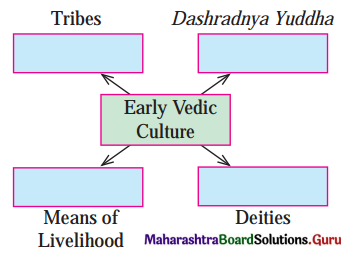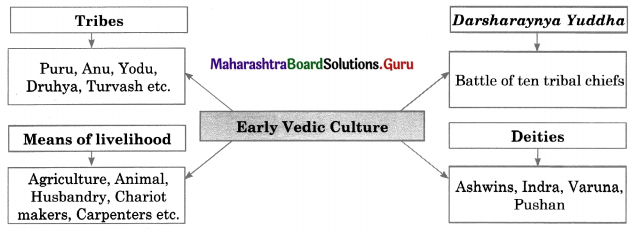Balbharti Maharashtra State Board Class 11 History Solutions Chapter 4 Vedic Period Textbook Exercise Questions and Answers.
Maharashtra State Board Class 11 History Solutions Chapter 4 Vedic Period
1A. Choose the correct alternative and write the complete sentences.
Question 1.
The importance of agriculture is clearly emphasised in the ______________ mandala of the Rigveda.
(a) 4th
(b) 10th
(c) 8th
(d) 6th
Answer:
(b) 10th
Question 2.
A potter is mentioned as an artisan in the ______________ for the first time.
(a) Rigveda
(b) Yajurveda
(c) Samaveda
(d) Atharvaveda
Answer:
(b) Yajurveda
![]()
Question 3.
The god who protected the animals was known as ______________
(a) Indra
(b) Pushan
(c) Ashwin
(d) Varun
Answer:
(b) Pushan
1B. Find the incorrect pair from set ‘B’ and write the correct ones.
Question 1.
| Set ‘A’ | Set ‘B’ |
| (a) Nishka | Gold ornament |
| (b) Barley | Maincrop of the Vedic people |
| (c) Krishtya | The apparatus of drawing water from the well |
| (d) Navya | River transport |
Answer:
(c) Krishtya – Tribal settlements
1C. Write the names.
Question 1.
A branch of linguistics.
Answer:
Philology
Question 2.
A battle was fought among the ten tribal chiefs.
Answer:
Dasharajnya Yuddha
Question 3.
Cultivable land prepared by ploughing.
Answer:
Urvara
![]()
2. Complete the concept map given below:
Question 1.

Answer:

3. Choose the correct reason and complete the sentence.
Question 1.
Panis were looked upon as enemies by the Vedic people because-
(a) they belonged to a different tribe.
(b) their language was impure.
(c) Panis used to steal the cattle of the Vedic people.
(d) Panis did not obey the orders of the Vedic people.
Answer:
(c) Panis used to steal the cattle of the Vedic people.
4. State your opinion.
Question 1.
There is a debate about the original home of the Aryans.
Answer:
- The debate began in the 16th Century. Till then the concept of the ‘Aryans’ was not known.
- The European academics became aware of the similarities between Sanskrit and Latin-Greek languages.
- This resulted in the notion of the Indo-European language family which gave momentum to the search for a Mother language from which developed the Indo-European languages.
![]()
Question 2.
The Rigvedic people subsisted on agriculture.
Answer:
- The Rigvedic tribal settlements have been mentioned as ‘Krishtya’ in the Rigveda. ‘Krish’ means ploughing.
- Hence the people who ploughed and also their settlements were mentioned as ‘Krishtya’.
- The importance of agriculture is clearly emphasised in the 10th mandala of Rigveda.
- It states that for the farmer his ploughshare is the means of obtaining.
5. Explain the following concepts.
Question 1.
Origin of Aryan people.
Answer:
- There are multiple unanswered questions, such as, who were the Aryans, did they arrive in India from a distant place or were they natives of India, which are the archaeological sites where the remains of their culture are found, how to identify those remains, etc.
- Most of the information about their culture is derived from Vedic literature. There are various v opinions about the chronology of the Vedic culture.
- However, there is a general agreement that the Vedic people composed Rigveda in India around 1500 B.C.E.
- However, Lokmanya Tilak calculated this date as 6000 B.C.E. on the basis of astronomical events.
- He was also of the opinion that the original home of the Aryans was in the Arctic region.
- This debate began in the 16th century. Till then the concept of the ‘Aryans’ was not known.
![]()
Question 2.
Indo-European family of languages.
Answer:
- In the year 1583, an Italian merchant by the name of Filippo Sassetti came to Kochi (Cochin) the port city in Kerala.
- He never returned to his motherland. He stayed in Kerala and Goa. During his stay, he wrote detailed letters to his family members about Indian life, language and culture. He happens to be the first European who wrote about his observations of Indian society.
- He also studied Sanskrit. He was the first one who observed the similarities between Sanskrit and Latin.
- His observations could be said to be the first, to give impetus to the notion of a family of Indo-European languages.